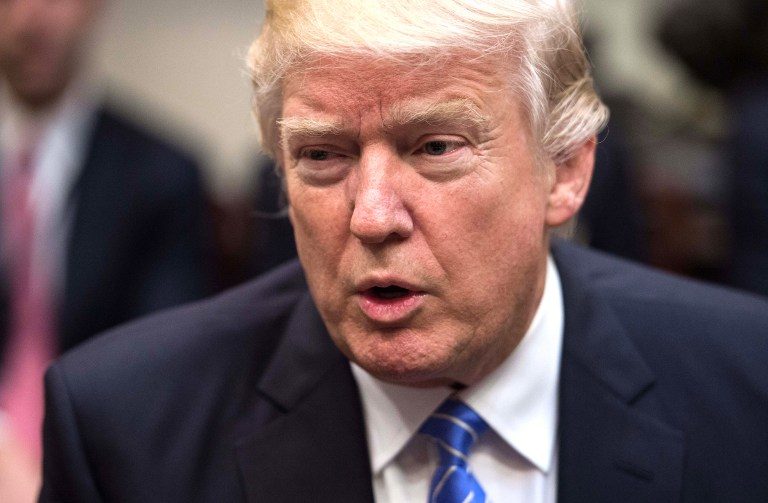SUMMARY
This is AI generated summarization, which may have errors. For context, always refer to the full article.

WASHINGTON DC, USA (UPDATED) – US President Donald Trump yanked the United States out of a major Pacific trade deal Monday, January 23, making good on an election campaign promise and delivering a hammer blow to Asian allies.
Trump said he had “terminated” the Trans-Pacific Partnership – a trade deal binding the United States, Australia, Canada, Japan, Vietnam and 7 other allies against growing Chinese economic clout.
Together, TPP members represent 40% of the world economy.
After signing an executive order, Trump said he would be “going back to those countries one-on-one” to find terms more favorable to the United States.
“We are going to have trade but we are going to have one-on-one,” he said.
“And if somebody misbehaves, we are going to send a letter of termination – 30 days and they’ll either straighten it out or we are gone.”
Trump came to office promising to gut existing trade pacts and reclaim manufacturing jobs lost overseas.
Trump has also vowed to renegotiate the North American Free Trade Agreement with Mexico and Canada.
Economists warn those jobs are never coming back and point to automation, not trade, as the main reason.
But Trump has sought to tap populist anger and argued for much more transactional trade deals, regardless of the impact on international norms and standards.
‘Serious mistake’?
According to a Peterson Institute analysis, the United States stood to be the biggest beneficiary from TPP, with an annual increase in exports of $357 billion.
The Institute also projected that the pact would be broadly neutral for employment levels.
President Barack Obama’s administration had also touted the deal as a strategic counterweight to China.
Trump’s Republican ally John McCain described the new president’s decision as a “serious mistake that will have lasting consequences for America’s economy and our strategic position in the Asia-Pacific region.”
“It will create an opening for China to rewrite the economic rules of the road at the expense of American workers. And it will send a troubling signal of American disengagement in the Asia-Pacific region at a time we can least afford it.”
It remains far from clear whether countries that have spent years negotiating the TPP would be willing to enter new talks.
“The US already has trade deals with 6 of the 11 TPP partner countries so that leaves a handful of countries for potential new deals, most notably Japan,” said Cathleen Cimino-Isaacs of the Peterson Institute.
“The emphasis on bilaterals is based on the perception that the US gave up too much in the TPP and will get better concessions from other trading partners in bilateral deals,” she said.
“But it’s not clear that would be the case. The US actually gave few new concessions in the TPP in big areas like services and government procurement,” Cimino-Isaacs added.
“At the same time, it was able to get greater concessions from countries like Japan in exchange for helping secure market access and agreement on high standards in other TPP markets.”
Tax cuts
Later Monday, Trump met with Congressional leaders and had private talks with the speaker of the House of Representatives, Paul Ryan.
Tax reform is likely to be high on the agenda.
“What we’re doing is we are going to be cutting taxes massively for both the middle class and for companies,” Trump said Monday.
To pay for those cuts, Trump has promised a “border tax,” which is likely to come in the form of increased tariffs on exports.
That move is likely to face a challenge at the World Trade Organization and from big-box retailers.
Trump also vowed Monday to cut regulation “massively” by up to 75%. It remains unclear how this would be done or quantified.
Rocky start
Trump signed two other executive orders Monday – freezing the hiring of federal workers and hitting foreign NGOs that help with abortion.
The Republican leader is looking to shift attention firmly back onto his policy agenda after a first few days that put his incoming administration on the back foot.
Since he was sworn in on Friday, January 20, Trump’s White House has been pilloried for lying to the public about inaugural crowds and over a campaign-style speech by the president before a memorial to fallen CIA officers.
On Saturday, January 21, several million Americans poured onto the streets for women-led demonstrations against Trump, the scale of which were unseen in a generation, in a potent rebuke to the president.
Trump has upbraided top aides over unfavorable media coverage on everything from crowd sizes to suggestions he has ruled out releasing his taxes. He is the first presidential candidate in recent memory not to do so. – Rappler.com
Add a comment
How does this make you feel?
There are no comments yet. Add your comment to start the conversation.